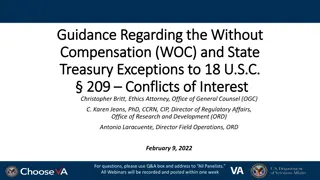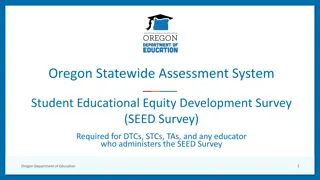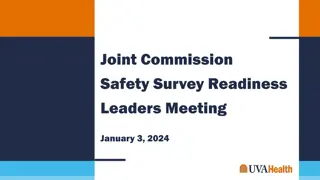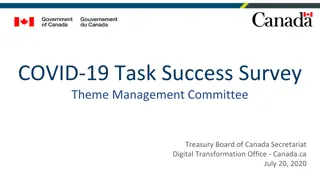COVID-19 Impact on Employees: Survey Results Overview
The Public Health Agency of Canada conducted a COVID-19 Employee Check-In Survey to understand the pandemic's effects on employees at work and home. The results highlight concerns regarding mental health, workload changes, communication effectiveness, and more. Insights show areas needing attention for employee well-being and organizational communication strategies.
Download Presentation

Please find below an Image/Link to download the presentation.
The content on the website is provided AS IS for your information and personal use only. It may not be sold, licensed, or shared on other websites without obtaining consent from the author.If you encounter any issues during the download, it is possible that the publisher has removed the file from their server.
You are allowed to download the files provided on this website for personal or commercial use, subject to the condition that they are used lawfully. All files are the property of their respective owners.
The content on the website is provided AS IS for your information and personal use only. It may not be sold, licensed, or shared on other websites without obtaining consent from the author.
E N D
Presentation Transcript
Public Health Agency of Canada's COVID-19 Employee Check-in Survey Results August 17th, 2020
Overview The COVID-19 Employee Check-In Survey was developed to gather data to better understand how the pandemic is impacting employees at work and home, and to inform the planning for easing of restrictions. Survey was open from July 8th July 29th. Overall response rate for PHAC was 54.9% (1,482 responses). Managers made up 23% of responses, while Employees made up 77% At the time of the survey, 73% of respondents were working remotely only. 9% continue to work on-site from their office/lab, while 16% work both on-site and remotely. This deck outlines overall trends and areas needing additional attention. Full results can be found attached in Appendix A. Heat maps by Branch can be found in Appendix B. 2
Key Takeaways Mental Health & Well-being Highlighting concern: According to respondents, the COVID-19 pandemic has resulted in a significant increase in workload and has negatively affected the mental health of employees. At the same time, most respondents indicated satisfaction with measures being taken to address mental health and know where to access resources when they need help. Significantly improved Moderately improved Moderately worsened Significantly worsened No change How has your ability to deliver work changed because of the COVID-19 pandemic? 8% 17% 41% 28% 6% Significantly reduced Moderately reduced Moderately increased Significantly increased Unaffected How has your workload been affected by the COVID-19 pandemic? 2% 10% 21% 32% 34% Significantly better Moderately better Moderately worse Significantly worse No change Compared to before the COVID-19 pandemic began (March 2020), how would you rate your mental health now? 5% 14% 28% 45% 8% Please indicate your overall level of agreement with the following statements on your well-being during the COVID-19 pandemic. Neither agree nor disagree Strongly disagree Strongly agree Not Disagree Agree applicable My work-life balance has improved 18% 24% 20% 20% 17% 1% The pressure to deliver work has affected my well-being. 9% 22% 29% 28% 11% 1% I am satisfied with the measures being taken by my organization to address my mental health and well-being. 6% 15% 32% 30% 14% 2% If I need help with my well-being, I am aware of the resources available to me (e.g., Employee Assistance Program). 1% 4% 8% 51% 36% 1% 3
Key Takeaways Communications On the Right Path: Overall respondents know where to get COVID-19 related information, though some are feeling overwhelmed with the amount of information. There were also concerns with the flow of information and timely decision-making from senior management. Please indicate your overall level of agreement with the following statements on communications during the COVID-19 pandemic. Neither agree nor disagree Strongly disagree Strongly agree Not % Strongly agree / agree Disagree Agree applicable I know where to find up-to-date departmental information related to COVID-19. 2% 9% 10% 50% 28% 0% 78% I find that there is too much information to keep track of and I feel overwhelmed. 5% 20% 27% 35% 13% 0% 48% Essential information flows effectively from senior management to staff. 10% 21% 24% 38% 7% 0% 45% My immediate supervisor keeps me informed about the issues affecting my work. 5% 9% 15% 50% 21% 1% 71% Senior department managers have been making effective and timely decisions. 8% 12% 36% 34% 9% 1% 43% Excludes "Not Applicable" 4
Key Takeaways IT Tools & Network Strong results: Respondents overwhelmingly agreed that they have sufficient access to IT equipment, collaboration tools, and IT support, and that access to the network & key applications is better now than two months ago. Please indicate your overall level of agreement with the following statements on IT tools and network during the COVID-19 pandemic. Neither agree nor disagree Strongly disagree Strongly agree Not % Strongly agree / agree Disagree Agree applicable I have access to the IT tools I need to work remotely (e.g., computer, monitor, mouse and keyboard). 2% 12% 8% 49% 27% 2% 78% I can effectively use the collaborative tools that are at my disposal (e.g., MS Teams Zoom, Slack). 2% 10% 9% 52% 26% 2% 79% I have been able to access IT support (e.g., Helpdesk) to resolve my technology issues. 1% 4% 9% 48% 28% 10% 84% I have had reliable access to the network when needed. 3% 13% 11% 49% 23% 1% 73% My access to the network and key applications (e.g., Outlook and critical applications) is better now than it was two months ago. 1% 7% 18% 38% 33% 3% 73% Excludes "Not Applicable" 5
Key Takeaways Home Workspace & Office Equipment Requiring focus: Many respondents are struggling with their home workspaces being adequate, as well as transporting and installing ergonomic equipment. Please indicate your overall level of agreement with the following statements on home workspace and office equipment. Neither agree nor disagree Strongly disagree Strongly agree Not % Strongly agree / agree Disagree Agree applicable I currently have an adequate home workspace that meets my needs. 9% 23% 10% 36% 19% 4% 56% I can safely transport ergonomic equipment that I have permission to remove from the office. 6% 16% 16% 25% 11% 26% 49% I can safely install my ergonomic equipment. 6% 15% 19% 23% 11% 27% 46% Excludes "Not Applicable" 6
Key Takeaways Involvement and Influence Strong results: While some respondents indicated that they could contribute more if assigned different work, the majority of respondents find their work meaningful and understand how their team is contributing to PHAC s pandemic response. Please indicate your overall level of agreement with the following statements regarding involvement and influence. Neither agree nor disagree Strongly disagree Strongly agree Not % Strongly agree / agree Disagree Agree applicable I have had regular check-ins with my supervisor. 3% 9% 7% 48% 33% 1% 81% My supervisor has provided me with flexible working arrangements. 2% 5% 11% 42% 35% 6% 81% My supervisor has clearly laid out my work priorities and deliverables. 4% 12% 17% 45% 21% 1% 66% I understand how my team is contributing to the Department's COVID-19 pandemic response. 2% 6% 8% 44% 39% 1% 84% I could contribute more to the organization's efforts if I were assigned different work. 9% 24% 31% 19% 13% 5% 33% My work is meaningful. 2% 6% 10% 47% 35% 0% 83% I feel connected to my colleagues. 5% 16% 18% 45% 16% 0% 61% I would like to be more engaged in helping shape the future of the workplace. 1% 6% 31% 39% 21% 2% 61% Excludes "Not Applicable" 7
Key Takeaways Policies and Processes Requiring focus: Many respondents are still unclear about how to report COVID-19 exposures/infections, as well as knowing what services are still available to them. However, the majority of respondents know how and when to access their offices/laboratories. Please indicate your overall level of agreement with the following statements on policies and processes. Neither agree nor disagree Strongly disagree Strongly agree Not % Strongly agree / agree Disagree Agree applicable I know what internal services are still operational (e.g., Pay Centre). 3% 22% 20% 43% 12% 1% 55% I know the process for reporting a COVID-19 infection or exposure. 5% 29% 13% 41% 11% 1% 52% I clearly understand under what circumstance code 699 should be used. 7% 17% 10% 47% 16% 3% 64% I know when and how to appropriately access my office building/laboratory. 2% 9% 10% 53% 22% 4% 78% Excludes "Not Applicable" 8
Key Takeaways Managers Management perspective: Despite indicating that their team s ability to work has been affected, the majority of managers responded positively about setting team priorities, knowing how to support their employees, and sharing COVID-19 updates. However some managers do not know the current options available for staffing positions. Please indicate your overall level of agreement with the following statements on your point of view as a manager during the COVID-19 pandemic. Neither agree nor disagree Strongly disagree Strongly agree Not % Strongly agree / agree Disagree Agree applicable I know how to support my employees and where to find the tools to address their well- being. 0% 7% 10% 60% 20% 2% 82% I regularly share updates related to COVID-19 with my team. 0% 7% 9% 49% 30% 5% 82% I can set priorities with confidence for my team. 1% 11% 8% 51% 27% 2% 80% I know the current options available for staffing positions. 6% 17% 12% 43% 17% 5% 63% My team's ability to work has been affected during this period. 5% 17% 6% 39% 31% 2% 71% My team has used remote collaboration tools. 1% 2% 3% 37% 54% 3% 94% Excludes "Not Applicable" 9
Key Takeaways Looking to the Future Post-Pandemic Scheduling: Many respondents indicated that they would like flexible working arrangements, indicating a strong preference for remote work post-pandemic. My preference for my post pandemic work schedule is: # (%) Return to the workplace full-time 107 7% 432 29% Work remotely full-time Have a flexible schedule 874 59% Not applicable I am required to work in the office/laboratory 69 5% Total 1,482 100% How often would you be interested in working remotely after re-entry to the workplace?* # (%) *Question offered to those who chose flexible schedule in the previous question. 1-2 days a week 359 41% 3-4 days a week 416 48% 99 11% Ad hoc/on occasion Total 874 100% Of those not required to work in a laboratory or office, the preference is to: # (%) Return to the workplace full time 107 8% Work Remotely: Ad hoc/on occasion 99 7% Work Remotely: 1-2 days a week 359 25% Work Remotely: 3-4 days a week 416 29% Work remotely full time 432 31% Total 1,413 100% 10
Key Takeaways Looking to the Future Safety in Public Spaces: Concerns regarding easing of restrictions center around the use of public transit, retransmitting COVID-19 to a high-risk family member, adequate/safe sanitation measures, and social distancing. When considering the prospect of returning to the workplace, please rate the extent to which the following factors cause you concern, anxiety, or fear. % Very or extremely concerned Strongly disagree Neither agree nor disagree Strongly agree Not Disagree Agree applicable 11% 17% 21% 21% 26% 4% 49% Returning before a vaccine is available 6% 4% 7% 13% 30% 41% 72% Commuting via public transit Safe use of public areas (kitchens, washrooms, cafeteria, elevators, etc.) 7% 14% 23% 27% 29% 1% 56% 8% 13% 21% 23% 29% 6% 56% Social distancing in the cubicle environment Concerns over lack of hand sanitizer or sterilizing wipes in the workplace 20% 19% 21% 18% 20% 2% 39% Concerns over workload imbalances of those working onsite vs. those continuing to work from home 30% 19% 22% 12% 13% 4% 26% The care for dependent children or family members while you are at work 11% 9% 7% 10% 20% 42% 53% 6% 22% 23% 21% 27% 1% 48% Fear of contracting COVID-19 while at work Fear of contracting COVID-19 while at work and retransmitting to high-risk family member 5% 12% 13% 21% 40% 9% 66% Excludes "Not Applicable" 11























